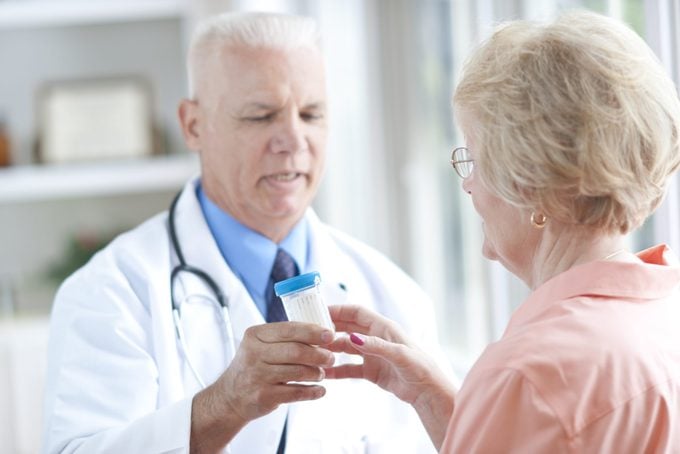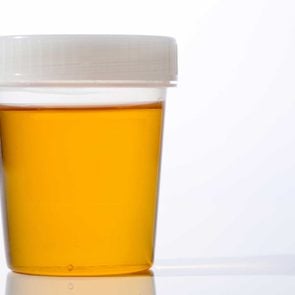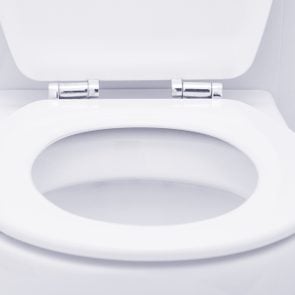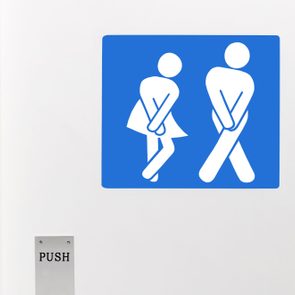What It Means If You Have Foamy Urine or Bubbles in Your Pee
Updated: Sep. 20, 2022
A few bubbles in your pee is normal. But foamy urine could be due to protein in your urine or other causes.
Why is my pee foamy?
When it comes to your health, it’s normal to worry when something is a little different—say when your pee color is a bit off. But what about when you have foamy urine, or it looks like it has bubbles in it? A single layer of bubbles in your urine that dissipates quickly is normal, says Zeyep Gul, MD, a urologist with the University of Pittsburgh Medical Center. Heavier foam, on the other hand, may not be.
“This is usually multiple layers and may not flush all the way,” says Dr. Gul.
Most of the time, foamy urine doesn’t mean anything and has no obvious cause. If it happens repeatedly, though, check it out with a doctor as it could be a sign of anything from dehydration or an infection to kidney disease.
Here are some other reasons and causes of foamy urine.
Get The Healthy @Reader’s Digest newsletter
Peeing fast and hard
It’s basic physics: The faster and stronger your stream, the more likely it is to produce foam.
“Certainly, a strong stream can result in foamy urine because the water in the toilet becomes turbulent and will produce bubbles,” says Elizabeth Kavaler, MD, a urologist with Lenox Hill Hospital in New York City and author of A Seat on the Aisle, Please!: The Essential Guide to Urinary Tract Problems in Women.
How Often Should You Pee? 11 Causes of Frequent Urination
Dehydration
Dehydration can make your urine look foamy simply because it’s more concentrated.
If you’re low on fluids, your urine is also more likely to be darker in color. Typically, pee should be lightish yellow and transparent, says Dr. Gul.
You can get dehydrated if you have diarrhea or are vomiting, if you’re running a fever, sweating (perhaps after exercising) or simply not drinking enough water.
Here’s How Much Water You Really Need in a Day, with Nutritional Scientists’ Latest Wisdom
Bacteria in your urine
Having bacteria in your urine can also produce foam.
“That does not mean that there is an infection [because] the bladder normally flushes bacteria out throughout the day.”
Enough bacteria, though, can indicate an infection. This often comes with other symptoms as well like burning when you pee and an urgent need to use the bathroom.
A sexually transmitted disease called trichomoniasis can cause a frothy discharge from the vagina (in women) or penis (in men) which might affect the urine.
10 Weird Reasons Your Pee Smells Funny
Protein in your urine
A more common cause of foamy urine is protein in the urine, says Elena Campbell, MD, a urologist with Ochsner Health System in Baton Rouge.
This is called proteinuria or albuminuria (albumin is the main protein in your blood).
Having protein in your blood is normal. Protein in your urine is not. It means your kidneys aren’t working properly.
Healthy kidneys filter waste products out of the blood while keeping protein inside where it’s needed for various bodily functions like healing tissue and fighting infections.
Protein in your urine can be a sign of kidney disease, which in turn might indicate you have diabetes or high blood pressure.
However, only about one-third of people who have foamy urine have detectable protein and, even then, it doesn’t necessarily mean anything is wrong, according to the Clinical Journal of the American Society of Nephrology.

Kidney disease
The only way to know for sure if you have protein in your urine is to have your healthcare provider do a urine test. They will put a dipstick into a sample of your urine.
The dipstick will change color if detects albumin, not unlike a pregnancy test. “It takes two minutes to get results and get in-office,” says Dr. Gul.
One positive test isn’t anything to worry about, but three positive results in a span of three months could mean you have kidney disease, according to the National Institute of Diabetes and Digestive and Kidney Diseases.
How to Prevent Kidney Failure: A Kidney Doctor on a Condition Affecting 37 Million Americans
Diabetes
Diabetic kidney disease, either from type 1 or type 2 diabetes, is the leading cause of kidney failure in the U.S.
Millions of tiny, specialized blood vessels in the kidneys filter out waste products from your blood through tiny holes. Those holes don’t allow larger protein molecules to exit the body.
If the high blood sugar levels characteristic of diabetes aren’t controlled, the glucose destroys the blood vessels and protein starts to “leak” out in the urine.
Early kidney disease usually doesn’t produce any symptoms, which is why it’s important for people with diabetes to control their blood sugar and have their urine monitored regularly.
7 Ways to Maintain Healthy Blood Sugar Levels
High blood pressure
Consistently high blood pressure has a similar effect on the kidneys, making hypertension the second leading cause of kidney disease.
The constant force of blood pushing through narrowed veins and arteries puts so much strain on the kidneys that they lose their ability to filter correctly. Again, protein escapes through the urine.
As with diabetes, the best way to prevent these problems is to take keep blood pressure in the safe zone. Diet and exercise as well as medications are the best way manage both hypertension and diabetes.
22 Foods That Can Help Lower Blood Pressure
When to seek help
Most of the time, foamy urine is nothing to worry about, but you should be vigilant if you have any risk factors for kidney disease. Foamy urine along with swollen legs and swelling around the eyes can be a sign of kidney damage. If you have these three together, get help immediately.
You should also see a doctor if you have pain with urinating, urinary incontinence, or blood in the urine, says Dr. Kavaler.
In most cases, foamy urine is nothing to worry about. If a culture is negative, but the symptom persists, your doctor may just ask you to return in a month, says Dr. Gul.
For more wellness updates, follow The Healthy on Facebook, Instagram, and Twitter. Keep reading:























